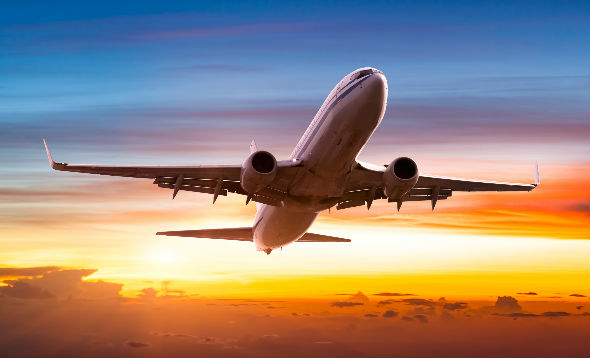That organic living is a conscious health choice
Effects of Travel on the Body
It’s hard to imagine that not too long ago, the use of air travel was limited to commerce, the military, or a select few of society’s most affluent members. While not quite on par with automobiles, planes are now widely considered a standard mode of transportation. For some, it’s almost the norm to take multiple flights within the span of a week.
While the aviation industry has essentially opened public access to practically all corners of the globe, the scientific community is still learning about the impact flying has on the human body. Whether flying short or long haul, regularly or occasionally, taking these conditions into account can make the time in the sky more comfortable and prevent any lasting side effects upon reaching your destination. Here are a few of the key health considerations that plane travel presents and how to prepare for them before your next take-off.
Low Moisture
The air in planes is dry. How dry? To the tune of a low four per cent humidity. Fluids naturally move by osmosis from areas of high to low concentrations. As such, these arid atmospheric conditions literally pull liquid from our mouths, skin, and lungs – parching our system inside out. When dehydrated, headaches, fatigue and dizziness can arise – making the ride less pleasant. Likewise, the mucus lining of our respiratory passages – our most superficial line of defence from infection - also requires sufficient moisture to protect us from debris and microbes. The dry air can also strip fluids from the digestive tract, contributing to travellers’ common complaints of constipation.
Your best travel mantra? Drink. Drink. Drink. Load up on hydrating beverages such as herbal teas and coconut water the day before your depart. Once airborne, tempting as your other options may be, ask the attendant for good old-fashioned H20 – still or sparkling. To stabilise your blood sugar levels and reduce your calorie intake, avoid sweetened sodas or fruit juices from concentrate. Consume alcohol and caffeine in moderation, as their diuretic properties make them less effective at hydrating. Plus, being stimulants, they can affect the quality of your sleep.
Low Pressure
As the plane ascends to the sky, the pressure in the cabin drops. Under these conditions, trapped air expands – which is why empty carry-on bottles inflate and packed lotions often explode, leak, and make a mess of our toiletry bags.
The same phenomenon occurs within the body with any air-filled space. This can aggravate joints, sinuses, or even recent dental work, and spell immediate migraines for individuals triggered by air pressure shifts. The most common side effect is of the digestive nature. Any gas trapped within the intestinal tract can swell, causing severe cramping and bloating until released - and plane cabins are hardly an opportune place for flatulence!
While there’s often little we can do to ensure that our intestines are void of any free air pockets, we can adjust our meal choices in advance to reduce the risk. Abstaining from gas-forming foods – like broccoli, cauliflower, cabbage, beans and even eggs – in the days prior to your trip is a good start.
Lack of Movement
Whether en route to the airport, waiting for departure or in the air, most travel itineraries entail hours upon hours in the seated position. These long periods of physical immobility translate to internal stagnation as well. Blood circulation is restricted, and blood can pool and potentially clot in the lower limbs. Fluids can also collect and cause swollen feet, ankles, and legs. Even the rhythmic contractions of the digestive muscles can slow down, causing irregular bowel movements. What can you do? If your budget allows, splurge on business or first-class tickets, or request for an exit row seat that offers more legroom. If given a choice, select a seat near to the aisle, so that you can stand up and take short walks - but not when the seatbelt light is illuminated, of course! Periodically, rotate your ankles and stretch your calves to encourage blood flow to the extremities and prevent cramps.
Bacterial Exposure
Another common concern with air travel is the exposure to infections and illnesses in the tight cabin space. Our immunity is really put to the test when we are on a flight. Any populated place can become a hotspot for disease transmission. Many travellers assume that the re-circulated cabin air supply is responsible for their post-holiday cold or flu. However, air travel experts claim that high efficiency particulate air (HEPA) filtration systems cut bacteria counts to levels lower than any office space. They assert that contact is the greatest pathogenic threat due to the many shared, high-contact surfaces. Despite standard sanitation protocols, the planes and airports’ numerous high-touch surfaces make perfect bacterial breeding grounds – where some bugs can survive for hours or even days.
To protect yourself, keep a distance from anyone who doesn’t seem to be in the best of health. After boarding, privately request to be relocated if your immediate neighbour is sneezing or coughing. Bring antiseptic wipes and give your immediate personal space - especially the seatbelt and the tray table - a quick wipe-down before unpacking and getting cozy. Practise hand hygiene and wash well with soap and warm water when possible. Strengthen your own defences in anticipation of your travels. In the week before you travel, get sufficient quality sleep, consider a probiotic supplement, and nibble on foods rich in vitamin C (fresh fruits and vegetables) and zinc (seafood, pumpkin seeds and tahini).
Time Zone Changes
We experience ‘jet lag’ when our internal body clocks, also known as our circadian rhythm, become disrupted as we cross multiple time zones. While not usually felt during our travels, this is an obstacle for travellers as they settle in a new locale. Depending on the difference in time between origin and destination, and your own personal resilience, it can take days or weeks to fully acclimatise. While popular, a plan to forgo sleep prior to trip and ‘catch up’ en route is not foolproof plan. Often the quality of our rest while flying is suboptimal – especially if you happen to be on a particularly turbulent flight or if there’s a crying infant onboard. Instead, get rest before you leave. You can also consider a slight adjustment in your bedtime – earlier or later - in the days before flying to sync your schedule with the place you’ll be visiting. Avoiding excesses in caffeine or alcohol at the airport and on the plane can also help. When you arrive, let the sun be your ally. Why? Melatonin, the hormone that regulates your sleep cycles, is photosensitive. So, adjust your exposure to light to help your body rebalance hormonally. During the day, spend time outdoors or expose yourself to brighter indoor light. Then, dim your lamps and electronic screens as the day winds down.
So, before you trot the globe for business or for pleasure, take into account the toll that airtime can take on your body. Any advance steps you take to take care of yourself can make can make for an easier, healthier journey.


























_1672804154.jpg)

_1611290459.jpg)